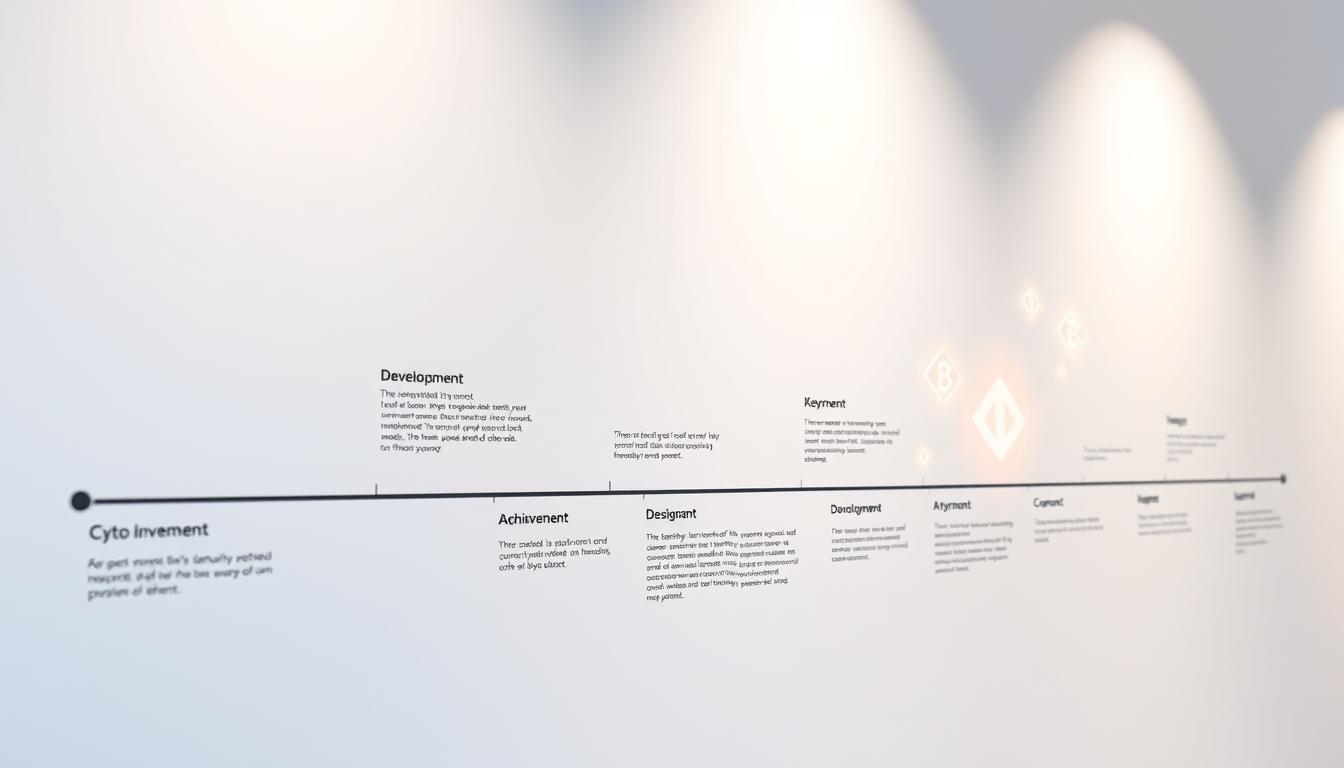Now Reading: Cryptocurrency Roadmap Development Milestone Timeline Explained
- 01
Cryptocurrency Roadmap Development Milestone Timeline Explained
Cryptocurrency Roadmap Development Milestone Timeline Explained

Imagine a blueprint for a skyscraper. It shows every step from the foundation to the final touches. In the world of digital assets, a similar blueprint exists. It guides projects from a simple idea to a fully functioning reality.
This strategic plan outlines goals, key achievements, and deadlines. It keeps developers focused and gives investors a clear view of progress. Without it, even the best ideas can lose their way.
Bitcoin offers a powerful example. The concept existed for decades before its launch in 2009. Through careful planning and execution, it grew into a major digital currency, reaching new heights by 2024.
This journey shows how a clear plan builds trust and transparency. In today’s fast-moving market, a well-defined path is no longer a luxury. It is a necessity for any project aiming for long-term success.
Key Takeaways
- Strategic plans act as essential blueprints for guiding digital asset projects from start to finish.
- These documents detail objectives, deliverables, and deadlines for everyone involved.
- Clear planning builds investor confidence and market trust by showing a commitment to transparency.
- Projects can fail due to poor execution, even with innovative ideas, highlighting the need for a solid plan.
- Understanding these structures is critical for making informed decisions in a volatile landscape.
- A strong plan tracks progress and allocates resources efficiently, acting as an execution engine.
Introduction: Understanding Crypto Roadmaps and Milestones
Consider a captain’s navigation chart plotting the course from departure to destination. In the digital asset space, a strategic plan serves this same vital function. It guides blockchain initiatives through their entire lifecycle.
What is a Crypto Roadmap?
A crypto roadmap is a comprehensive document outlining a project’s journey. It details everything needed for a blockchain-based initiative to progress from idea to launch and beyond. This strategic plan covers objectives, deliverables, and deadlines.
The document serves as an execution engine tracking progress and allocating resources. It builds transparency with the community and investors. Key elements include vision statements, specific achievements, planned features, timelines, and team identification.
The Role of Milestones in Project Success
Milestones mark significant progress in development. They serve as key indicators of success for any crypto project. These markers help maintain momentum and community engagement.
Each achieved milestone validates project credibility. It demonstrates team commitment and technical competency. Regular updates on milestones foster trust and transparency.
Projects like Cardano show effective milestone structuring. Their distinct phases—from core infrastructure to smart contracts—demonstrate clear progress markers. This approach establishes foundation for long-term viability.
Cryptocurrency roadmap development milestone timeline: Key Components
Every impactful digital venture begins with a foundation built on clear strategic components. These elements form the backbone that supports growth and guides execution.
Vision, Objectives, and Development Phases
A strong project vision identifies specific market problems. It clearly states who benefits from the solution. This foundation comes before any technical work begins.
Objectives must be specific and measurable. They align directly with the overall vision. Each phase builds systematically on previous achievements.
The development process typically moves from concept discovery to MVP creation. Then it progresses to launch preparation and post-launch growth. Clear deliverables and timelines mark each stage.
Ensuring Transparency and Building Trust
Regular updates create essential transparency. Teams should share progress through official websites and social channels. This openness builds trust with investors and the community.
Prompt responses to questions demonstrate accountability. Honest disclosure of challenges strengthens credibility. These practices establish the foundation for long-term success.
Effective communication channels keep stakeholders informed. They provide clarity about the project’s direction. This engagement sustains investor confidence through all phases.
Timeline Milestones: Lessons from Bitcoin to Modern Crypto Projects
Looking back at Bitcoin’s fifteen-year trajectory reveals critical patterns for contemporary digital initiatives. This journey demonstrates how external factors shape project evolution and investment outcomes.

Historical Milestones and Their Impact
Bitcoin’s launch in 2009 began with zero monetary value. By 2011, it crossed the $1 mark, showing early potential. The 2013 period brought significant growth when Forbes named it the best investment.
External events consistently influenced Bitcoin’s price trajectory. The 2017 bull run pushed values to nearly $20,000. COVID-19 uncertainty in 2020 created a 416% surge.
Recent years showed extreme volatility with peaks above $69,000 and crashes below $20,000. The 2024 ETF approvals marked a major historical achievement.
Adapting to Market Trends and Global Shifts
Successful crypto projects must remain flexible in their planning. Bitcoin’s history shows that even well-structured plans need adjustment.
Market crashes, regulatory changes, and global events require adaptable strategies. Maintaining core vision while accommodating external factors is essential for long-term success.
Modern initiatives should build flexibility into their timeline planning. This approach helps navigate the unpredictable digital asset landscape effectively.
Strategic Phases and Execution in Crypto Project Development
Effective blockchain initiatives progress through well-defined operational stages. Each phase builds upon the previous one, creating a logical progression from idea to implementation.

Proper phase structuring ensures teams achieve their objectives systematically. This approach minimizes risks and maximizes resource efficiency throughout the project lifecycle.
Planning, Resource Allocation, and Risk Management
The initial concept phase involves thorough market research and team formation. Blockchain developers and legal advisors collaborate during this critical stage.
Smart contract development follows, with rigorous testing and security audits. Private testing programs validate token functionality before public release.
Resource allocation must cover technical work, marketing, and compliance needs. A solid crypto business plan template helps organize these resources effectively.
Navigating Regulatory and Compliance Challenges
Legal frameworks vary significantly across jurisdictions. Projects must analyze regulations for tokens and securities early in their planning.
KYC/AML procedures build investor trust and meet international standards. Exchange listing applications require careful adherence to compliance requirements.
Ignoring regulatory adaptability can lead to serious challenges. Comprehensive legal planning prevents costly delays and ensures long-term viability.
Leveraging Transparency for Investor Confidence
Think of a thriving digital ecosystem where community members actively shape the project’s direction. This level of involvement creates lasting value beyond simple financial investment. True transparency builds the foundation for sustainable growth.

Effective Communication and Community Engagement
Successful projects establish multiple communication channels. Platforms like Telegram, Discord, and X (Twitter) enable direct dialogue with users. Regular updates keep stakeholders informed about progress.
Weekly AMA sessions address community questions openly. Teams share both achievements and challenges honestly. This approach builds credibility and maintains positive momentum.
Incentive programs strengthen community bonds. Airdrops reward early supporters while staking programs encourage long-term holding. These strategies create genuine engagement beyond temporary hype.
Educational content helps new users understand complex technology. Comprehensive guides and tutorials reduce participation barriers. This investment in user education demonstrates commitment to community growth.
Strategic partnerships amplify transparency efforts. Collaborations with aligned projects provide greater market exposure. Co-branding initiatives build additional trust through association.
Integrating Key Features to Enhance Your Crypto Roadmap
Think of building a digital city where infrastructure choices determine future growth and connectivity. Technical architecture forms the foundation of every successful digital asset initiative. Smart technology decisions create lasting value for users and investors alike.
The right technical approach separates promising projects from temporary trends. It ensures long-term viability in a rapidly changing market landscape.
Innovative Technologies and Functional Enhancements
Blockchain selection represents a critical early decision for any digital initiative. Teams should evaluate platforms based on specific project needs rather than popularity. Factors like scalability, transaction costs, and existing ecosystems matter most.

EVM-compatible chains like Ethereum offer established developer communities. Non-EVM alternatives provide different advantages for specific use cases. The table below compares key selection criteria:
| Selection Factor | EVM-Compatible Chains | Non-EVM Chains |
|---|---|---|
| Scalability | Layer-2 solutions needed | Native high throughput |
| Transaction Fees | Variable, often higher | Typically lower |
| Ecosystem Maturity | Extensive tools and resources | Growing but newer |
| Integration Complexity | Standardized approaches | Custom development required |
Smart contract design should emphasize modular, upgradable architecture. This allows teams to add new features without complete redeployment. It demonstrates technical maturity and future-proofs the initiative.
Integration strategies position tokens as open ecosystems rather than isolated assets. Connecting with major wallets and exchanges provides immediate usability. Pre-packaged SDKs and APIs encourage third-party developer participation.
Multi-chain planning brings users from diverse blockchain systems. It protects projects from platform-specific risks while expanding market reach. This approach creates genuine value for target users.
Conclusion
Consider a foundation that transforms innovative concepts into sustainable digital ecosystems. A well-structured strategic plan provides this essential framework, guiding initiatives from vision to reality. It combines clear goals with measurable milestones, creating a path for consistent growth.
For investors, evaluating a crypto project requires careful analysis of its strategic elements. The quality of planning, team credibility, and communication transparency serve as critical indicators. These factors help identify projects with genuine potential for long-term success.
Effective strategic documents are living tools that adapt to market trends. They maintain community engagement and demonstrate accountability throughout the journey. This approach builds the trust necessary for sustainable blockchain ecosystems.
FAQ
What is the main purpose of a crypto project roadmap?
A roadmap outlines a project’s vision, objectives, and planned phases. It serves as a strategic guide for the team and provides clarity for investors. This transparency helps build trust and manage expectations by showing the planned journey and growth.
How do milestones contribute to a project’s success?
Milestones are specific, achievable goals that mark progress. They demonstrate tangible achievements, build momentum, and keep the community engaged. Hitting these targets reinforces investor confidence and shows the team’s commitment to its plans.
Why is community engagement so important in blockchain initiatives?
A strong community provides valuable feedback, helps test new features, and spreads awareness. Active engagement through social media and other channels creates a loyal user base. This support is vital for long-term growth and adoption in the competitive market.
How can investors assess the risks associated with a new project?
Investors should review the roadmap’s realism, the team’s experience, and the technology’s potential. They should also monitor communication for updates on progress and any changes. Understanding the project’s solutions to market challenges is key to evaluating its potential value.
What role does technology play in enhancing a project’s features?
Innovative technology is the backbone of any blockchain project. It enables new functionalities, improves security, and scales the network. Integrating the latest trends ensures the project remains competitive and can deliver on its promises to users.
How do projects adapt their timelines to changing market conditions?
Successful teams remain agile, monitoring the broader landscape and global shifts. They may adjust their phases or reallocate resources to address new regulations or trends. Clear communication about any timeline changes is essential for maintaining trust.











